Water from the source may contain an increased amount of iron, which adversely affects human health. Poor quality indicators of the liquid provoke damage to engineering networks and household appliances. In order to get rid of these problems, a water deironing station is used. The choice of equipment is carried out on the basis of the prepared project.
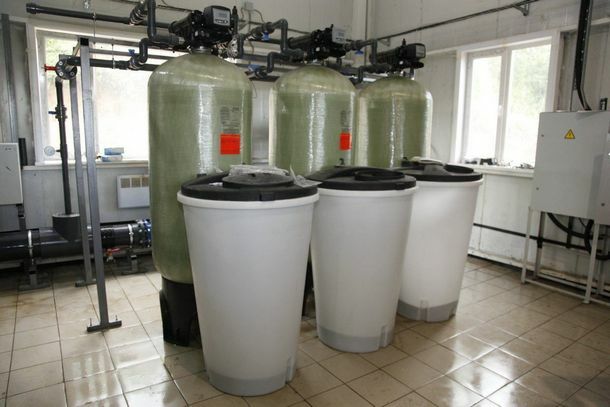
Harm of iron in water from a well in a private and country house
We list the negative consequences that provoke an increased content of harmful impurities:
- deterioration in the taste of water;
- the appearance of an unpleasant odor and color;
- sediment formation;
- the appearance of persistent stains on things after washing and on plumbing surfaces;
- strengthening the scale layer on dishes and household appliances;
- development of allergic reactions, dysbacteriosis, anemia, and other diseases.
The permissible concentration of iron according to SanPin standards is limited to the level of 0.3 mg / l. The actual value of this indicator will be determined by laboratory analysis. These data are necessary to select a suitable water deironing station for a private house.
There is no point in investing a lot of money in a project if the cause of the problems is not eliminated.
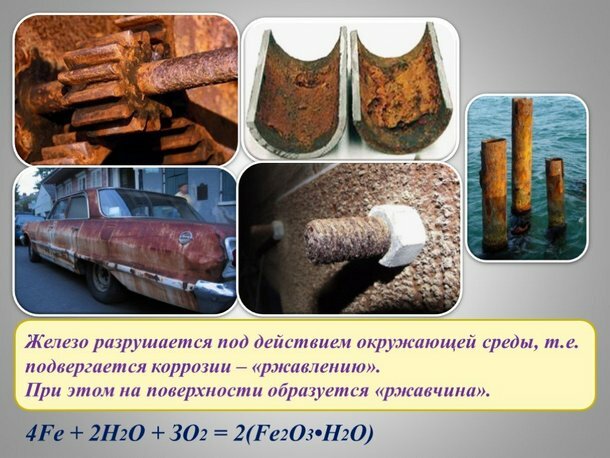
Let's note the sources of the substance in question getting into technical (drinking) water:
- erosion of rocks and soil;
- pipe corrosion;
- oxidation of pumping equipment;
- precipitation pollution.
In some situations, before the implementation of a new project, it is necessary to eliminate the corresponding damage and shortcomings of the water supply system. This will reduce the load on the filtering equipment and reduce the cost of its assembly.
The principle of operation of the water treatment and deironing station
Aeration is traditionally used to eliminate the contaminants in question. Saturation of water with oxygen oxidizes iron and releases it in the form of a precipitate. The formed solid particles are retained by a mesh or other mechanical barrier.
The treatment process is accelerated by a forced air supply scheme by a high-pressure compressor into the work string through a switchgear. Ozonation or dosed addition of special reagents to the liquid is also used.
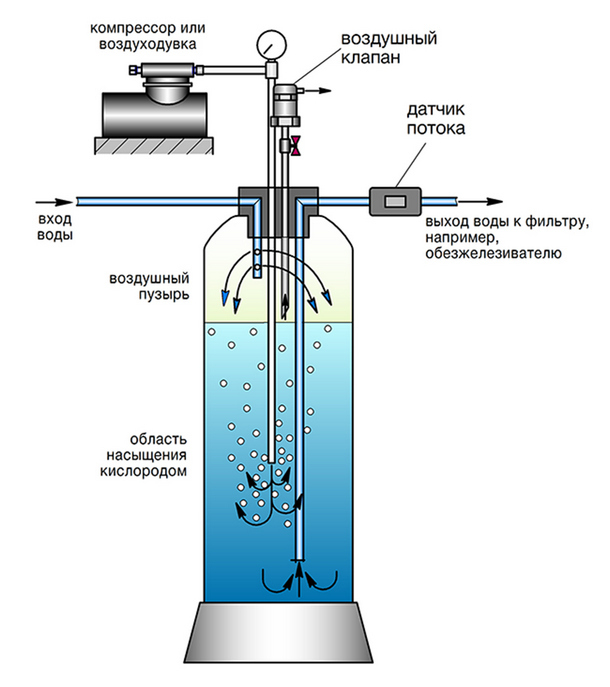
The general principle of operation is to convert the solute into a precipitate. The next step involves the separation of mechanical impurities from the liquid stream by equipment with a suitable level of filtration.
TOP-5 domestic and industrial water iron removal stations
Profile companies offer specialized equipment to solve the indicated problem. For a correct assessment of costs (ease of use and other important factors), you should study the features of typical models.
1 place. hollow fiber
2nd place. electromagnetic
3rd place. reagent
4th place. Aeration
5th place. Ozone
hollow fiber
When choosing this method, professional knowledge and special security measures are not needed. In this case, we are talking about the rules for the use of a productive main filter with a special working element that is capable of retaining microscopic fractions - from 0.01 microns.
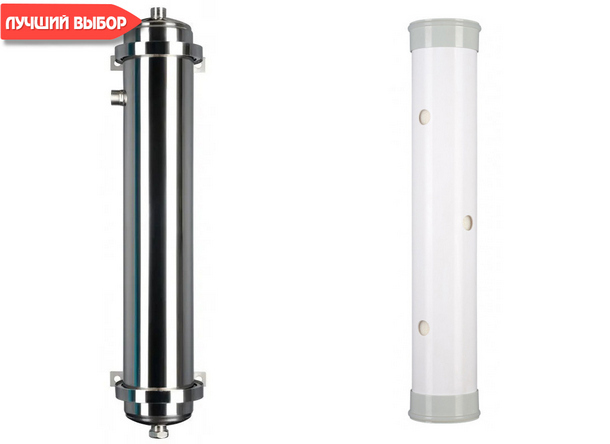
Such a device is used after aeration to remove even the smallest suspensions with a guarantee. After processing, the consumer will receive at his disposal clear water without microorganisms, since their dimensions are larger compared to the pores in the walls of hollow fiber tubes.
For a more thorough assessment, when comparing models with the same throughput, the resource is refined. Membranes in the basic version are produced for single use. After contamination, they must be disposed of. A more profitable option is a flushable module. Pure water is used to remove mechanical impurities from it. If the filter housing has a separate outlet, you can perform this procedure without disassembling the structure.
electromagnetic
The main purpose of this technology is the fight against scale. Quite often, magnesium and calcium salts are present along with iron in contaminated well water. Appropriate treatment blocks their deposition and the formation of a strong porous layer on the surfaces of the heating elements.
This type of signal amplification effect can be used for reagentless flocculation. With its help, small iron particles are combined into larger fractions (up to 1 micron), which are retained by a mechanical filter without any problems. At the same time, the ability to prevent scale formation is preserved.
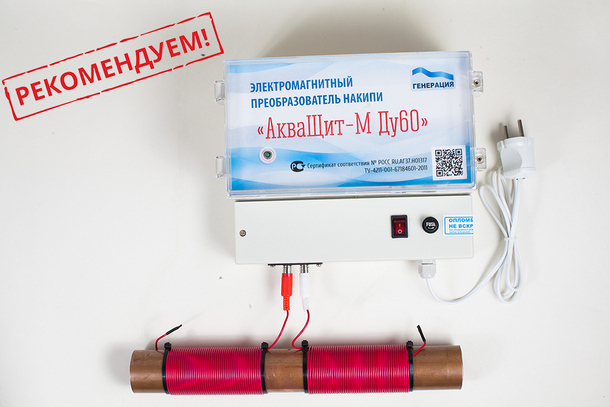
To evaluate technical means, the following parameters are checked in the complex:
- installation range;
- acceptable level of hardness in the source;
- power consumption and signal frequency;
- protection of the electronics unit from dust / moisture according to the IP standard.
A characteristic advantage of this method is the ease of handling. The functional components of the equipment do not come into contact with water, which prevents their wear. They do not create additional resistance to flow, so the pressure drop does not need to be corrected by the pump. The only drawback is the lack of filtration capabilities. Harmful pollution will have to be removed using other technologies.
reagent
The addition of strong oxidizing agents intensifies the oxidation of iron in the divalent form. This method is effective even in cases where aeration is powerless. With its help, persistent organic compounds are destroyed: lingins, humates, etc.
Accurate calculation is needed to reproduce the workflow correctly. The active substance is spent on the oxidation of other impurities and disinfection. Changes in the composition of contaminants should be corrected by a special setting. the flow rate and the temperature in the working area should also be taken into account.
The most popular method of reagent treatment is chlorination. This technology has been well studied. It allows simultaneous disinfection. An additional advantage is the low cost of chlorine.
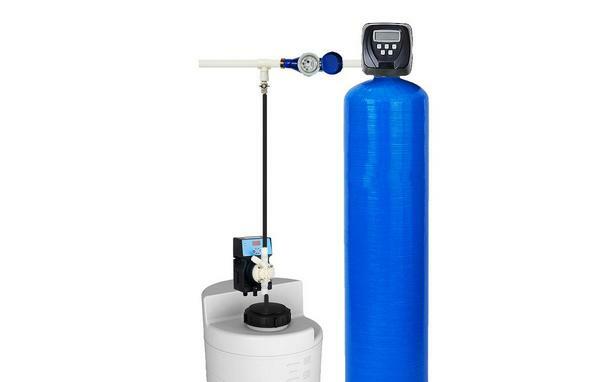
On the other hand, the costs of handling a highly toxic substance increase. To avoid harm to users, you will need to use reliable equipment and carefully follow special safety measures.
The noted features explain why chlorination seems to be more preferable for solving professional problems. At enterprises, the reproduction of the technical process is provided by expensive equipment equipped with automated controls. Correct maintenance of equipment is ensured by trained personnel.
Aeration
Aeration is the most common method of water iron removal - the forced addition of air to the working area using a special compressor.
Automatic switching on by a signal from a flow sensor is added to a typical set of equipment. This allows you to save energy. Air is supplied directly to the line or to a separate container through a switchgear. When equipped with a tank, it is filled with a filter load and equipped with a drain for purified water in the lower part.
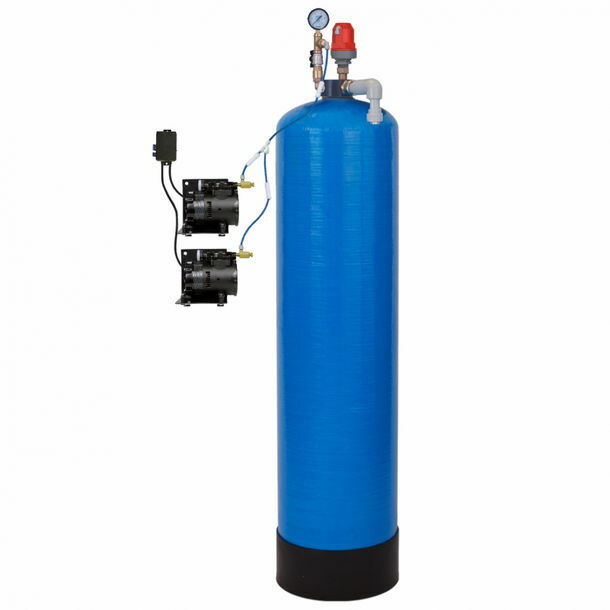
Alternative methods of aeration:
- introduction of air through the ejector (without pressure);
- sprinkling of water by spouting;
- similar separation of liquid flow through the shower head.
For the calculation, it is necessary to take into account the restriction on the content of iron - no more than 10 mg / l. If the concentration is 2 times less, for effective processing, the aeration time is set within 14-15 minutes. During this procedure, the pH indicator temporarily decreases. In case of more severe contamination, preliminary preparation using a strong oxidizing agent is required.
Ozone
When working with these installations, specialists pay attention to the following advantages:
- minimal contamination of the liquid by products of adverse reactions;
- no increase in salt composition;
- ease of full automation.
Ozone is produced directly at the well water deironing station using a high-voltage spark gap. Atmospheric air can be used as raw material. Interaction with the aquatic environment occurs in several stages. At the first stage, direct oxidation is performed. On the second stage, reactions with active radicals are reproduced.
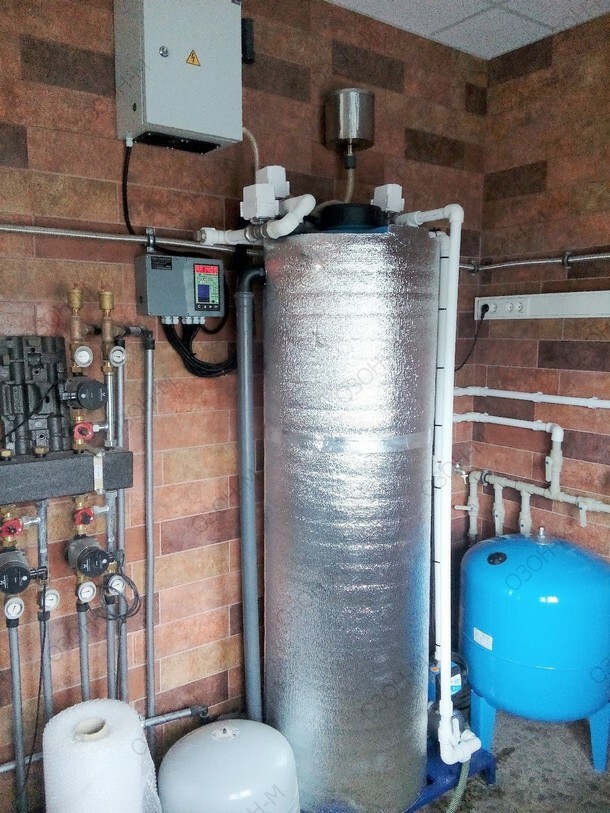
To ensure a high level of security, it is recommended to use professional category installations in everyday life. Appropriate equipment is more expensive compared to the simplest counterparts. However, this increase in budget justifies the reliability of the functional components. The concentration of ozone in the atmosphere is more than 0.1 mg per cubic meter. prohibited by current health regulations.
Price at the iron removal station
We will consider the costs of equipment for the presented technologies using examples of serial models along with the main technical characteristics.
Aquaflow is suitable for electromagnetic flocculation (22,500 rubles):
- range - 2000 m;
- water hardness - up to 28 mg-eq / l;
- electricity consumption - 25 W;
- the outer diameter of the compatible coil winding tube is up to 60 mm.
The AROS-1 reagent plant with a dispenser and additional filters is offered for 89,900 rubles:
- processing speed - 1000 l / h;
- power consumption - 2 kW;
- overall dimensions (Length x Width x Height) - 1500 x 750 x 1200 mm.
The following list shows the technical characteristics of the Aquaris hollow fiber membrane in a set with a housing (55,700 rubles):
- dimensions - 515 x 161 mm;
- productivity - 3000 l / h;
- working temperature – not higher than +45°C.
Aeration station for water purification and iron removal AP 1465 AS costs 47,550 rubles:
- productivity - 2000 l / h;
- pressure - no more than 6 atm;
- weight - 25 kg;
- dimensions (Width x Height x Length) - 3600 x 1650 x 510 mm.
For ozonation, you can choose OZONE-1 (175,000 rubles):
- the amount of water processed per hour - 1000 l;
- power consumption (together with the pump) - 750 W;
- inlet pressure - not less than 2.5 atm.
Detailed information about models is presented on the websites of manufacturers.
Where to buy and order station construction, installation and maintenance?
Use the services provided by the official sales network and authorized service centers. These enterprises sell mass-produced products without large margins. They provide qualified technical service and warranty support.
Summing up
Consider the price in the store as part of the cost. To draw up a correct financing plan, delivery, connection and other related work should be taken into account. Prepare a preliminary water treatment project based on the analysis of impurities with the help of specialists. This approach will help to perform iron removal correctly and inexpensively.


